
- Home
- India
- World
- Premium
- THE FEDERAL SPECIAL
- Analysis
- States
- Perspective
- Videos
- Sports
- Education
- Entertainment
- Elections
- Features
- Health
- Business
- Series
- In memoriam: Sheikh Mujibur Rahman
- Bishnoi's Men
- NEET TANGLE
- Economy Series
- Earth Day
- Kashmir’s Frozen Turbulence
- India@75
- The legend of Ramjanmabhoomi
- Liberalisation@30
- How to tame a dragon
- Celebrating biodiversity
- Farm Matters
- 50 days of solitude
- Bringing Migrants Home
- Budget 2020
- Jharkhand Votes
- The Federal Investigates
- The Federal Impact
- Vanishing Sand
- Gandhi @ 150
- Andhra Today
- Field report
- Operation Gulmarg
- Pandemic @1 Mn in India
- The Federal Year-End
- The Zero Year
- Science
- Brand studio
- Newsletter
- Elections 2024
- Events
- Home
- IndiaIndia
- World
- Analysis
- StatesStates
- PerspectivePerspective
- VideosVideos
- Sports
- Education
- Entertainment
- ElectionsElections
- Features
- Health
- BusinessBusiness
- Premium
- Loading...
Premium - Events
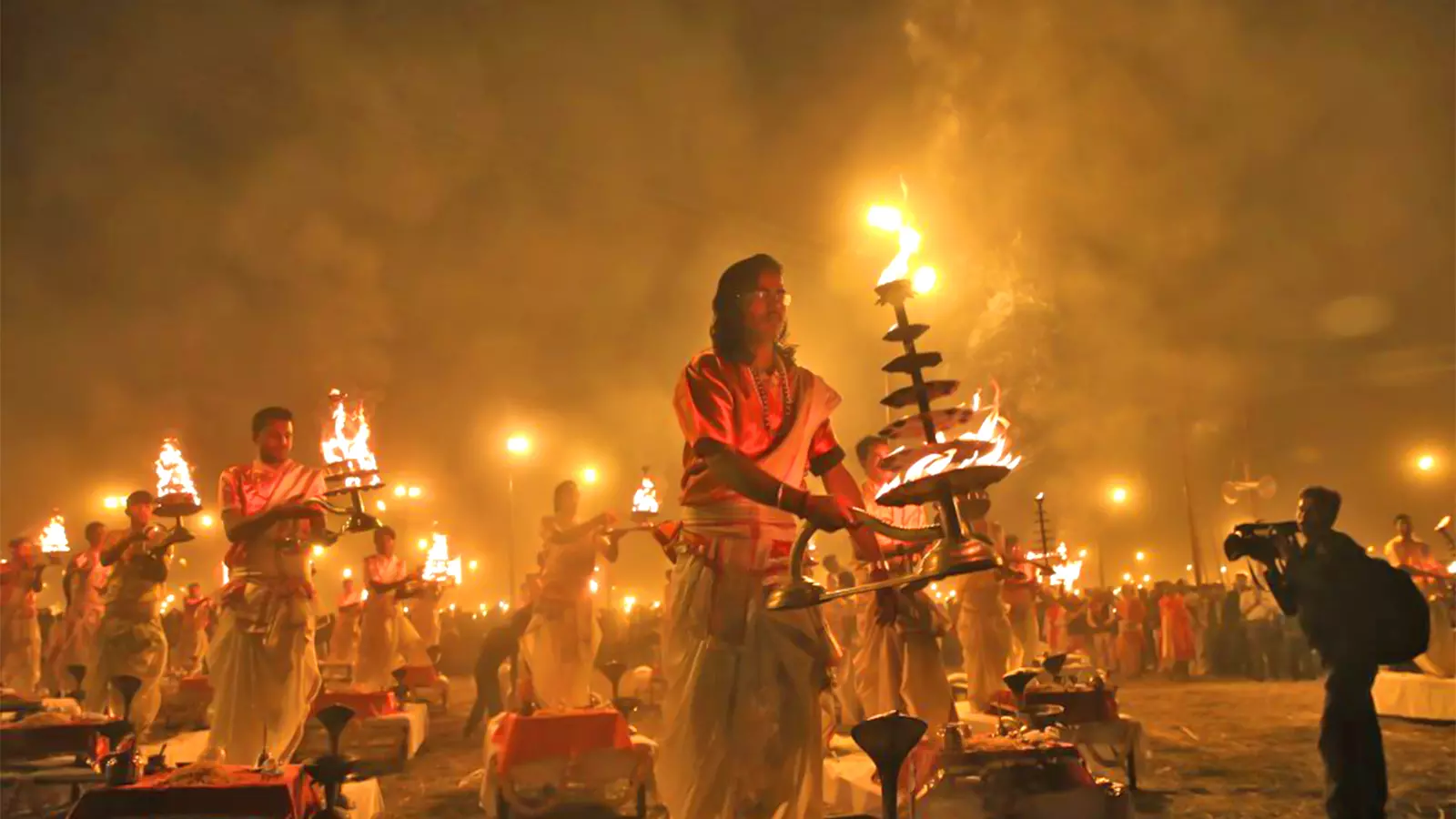
Separated by a distance of just a little over 200 kilometres, Ayodhya and Prayagraj are both gearing up for mega festivities — Prayagraj for Magh Mela starting January 15 and Ayodhya for Ram Mandir inauguration on January 22. Unfazed by the preparations required, Chief Minister Yogi Adityanath is determined to scale up both events. The Yogi-led Uttar Pradesh government doesn’t see one...
Separated by a distance of just a little over 200 kilometres, Ayodhya and Prayagraj are both gearing up for mega festivities — Prayagraj for Magh Mela starting January 15 and Ayodhya for Ram Mandir inauguration on January 22. Unfazed by the preparations required, Chief Minister Yogi Adityanath is determined to scale up both events. The Yogi-led Uttar Pradesh government doesn’t see one coming in the way of the other.
“This year’s Magh Mela would be a special one. It coincides with the re-consecration of Ram Lalla idol in Ayodhya on 22 January after 500 years. A large number of people going to Ayodhya would also visit Prayagraj on the way to take a holy dip at the Prayag Sangam. As Kumbh Mela is scheduled for 2025, this Magh Mela would be the dress-rehearsal for that grand event. Hence, we are going all-out to prepare for the grandeur of the occasions,” said Yogi on 28 December, during a visit to Prayagraj to oversee the preparations for the event.
For the Bharatiya Janata Party, scaling up the events is natural. The 54-day Magh Mela would be followed by the general elections.
The significance of Magh Mela
Magh is the 11th month of the Hindu calendar, falling in Sishir Ritu, the late winter months of January-February every year. Magh Mela, however, is no ordinary fair. It is a humongous religious congregation primarily meant for a holy dip in the sacred waters of Ganges by around 50 to 60 million people in Prayagraj, considered a holy city by Hindus.
People flock to the city from across the country, some even on foot, to participate in one world’s largest pilgrimages. If there is one thing that matches the religious fervour of the event, it is its commercial importance. Magh Mela is also a gigantic commercial event as businesses, ranging from multinational firms to tens of thousands of modest small-time hawkers and shopkeepers, gather there to market their wares to millions. In other words, it is a colossal trade fair, a collection of thousands of village fairs coming to the city all at once.
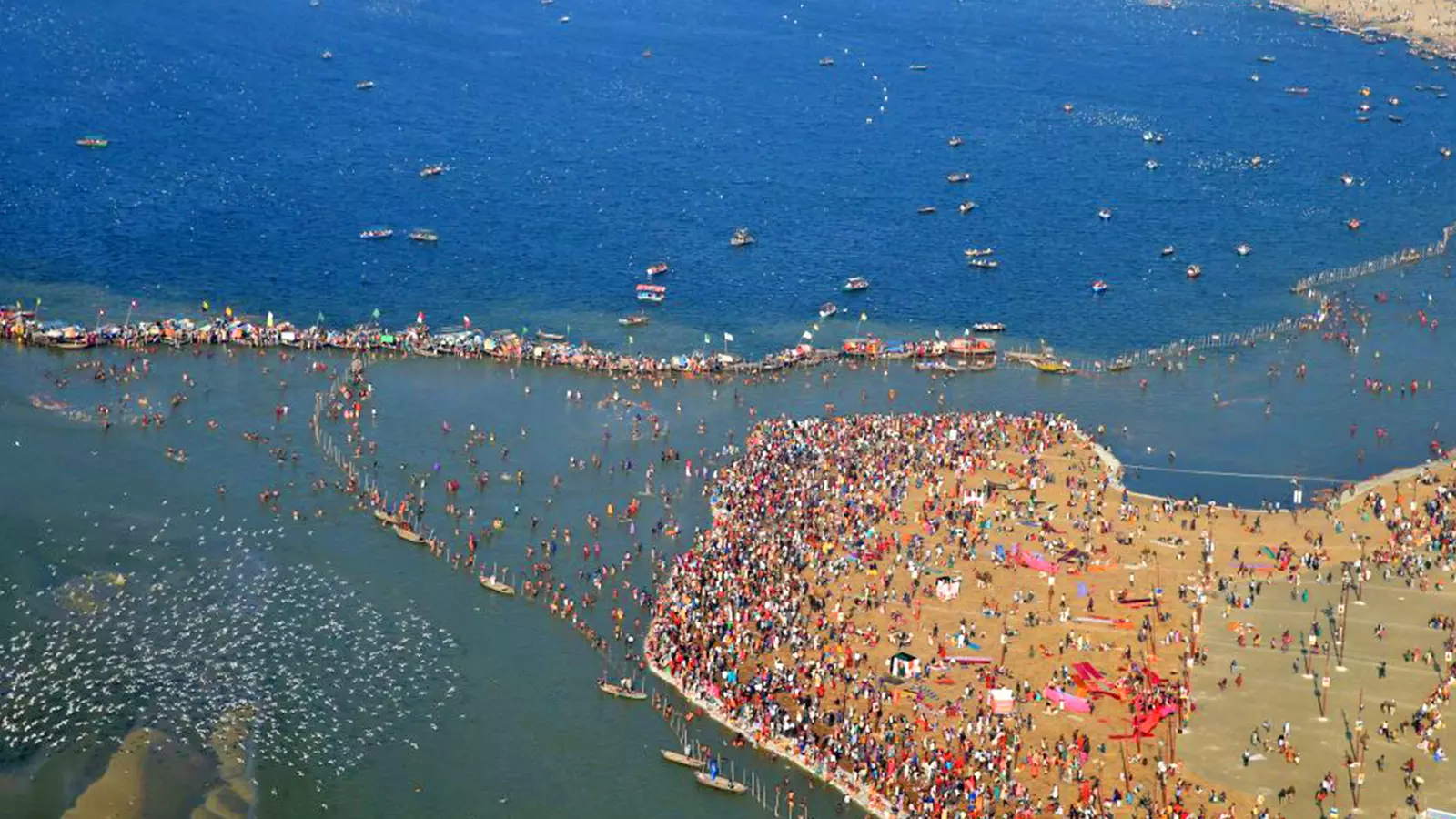
It is expected that a large number of people going to Ayodhya would also visit Prayagraj on the way to take a holy dip at the Prayag Sangam.
Thanks to its religious aura, Magh Mela is a major attraction for religious tourism. Since Varanasi and Prayagraj, until recently known as Allahabad, are the Mecca and Medina of Hinduism, even during normal times Prayagraj is a major tourist destination. During Magh Mela, the number of visitors swells to millions.
Apart from being an amalgamation of bhakti and business, in social terms, Magh Mela is a joyous cultural carnival of millions marked by gala celebrations and joyful festivity — a mela in the true sense.
In other words, it is a massive multifaceted affair which is simultaneously a Hindu religious congregation, a protracted pilgrimage, a mass carnival marked by the performances of hundreds of folk cultural groups, and a big bazaar of thousands of sellers with an overall turnover of nearly a thousand crore rupees—all rolled into one.
Magh Mela in history
Magh Mela dates far back in history and its references are even found in ancient mythological tales. In the Adi Parva of Mahabharata it is mentioned that Pandavas participated in Magh Mela during their exile. An entire chapter is devoted to Magh Mahatmaya (the grandeur of Magh) in Padma Purana and it also finds mention in Vishnu Purana. The eighth century Vedic scholar Adi Shankara had chronicled the auspicious occasions of Kumbh Mela and Magh Mela in his writings and teachings.
Anamika Roy, a professor in the Department of Ancient History, Culture and Archaeology of Allahabad University, told The Federal, “Under the Mughal regime, there was neither any patronage nor restriction on Magh and Kumbh Melas. They were organised primarily by the Dasnami Naga Akhada and only Emperor Akhbar made some contribution once.”
Melas are part of the cultural tradition of Hindus. The Hindu mythology has it that Lord Vishnu was carrying nectar in a kumbh (pitcher) and four drops from it spilled in four places—Prayagraj, Nashik, Ujjain and Haridwar. Hence, Kumbh Mela is observed in all these four places once in 12 years. Ardh Kumbh (literally, semi-Kumbh) is observed once in six years. Magh Melas are annual mini versions of the Kumbh Mela.
Prayagraj has emerged as an important holy city historically in the medieval riverine civilization of the Gengetic belt. The annual Magh Melas and the once-in-12-years Kumbh Melas primarily define its identity. The last Ardh Kumbh in Prayagraj was observed in 2019. The next Purna Kumbh or full-fledged Kumbh Mela would be observed in 2025 which makes the annual Magh Mela a special one as a preparatory step from the point of view of logistics and event-organising by the administration.
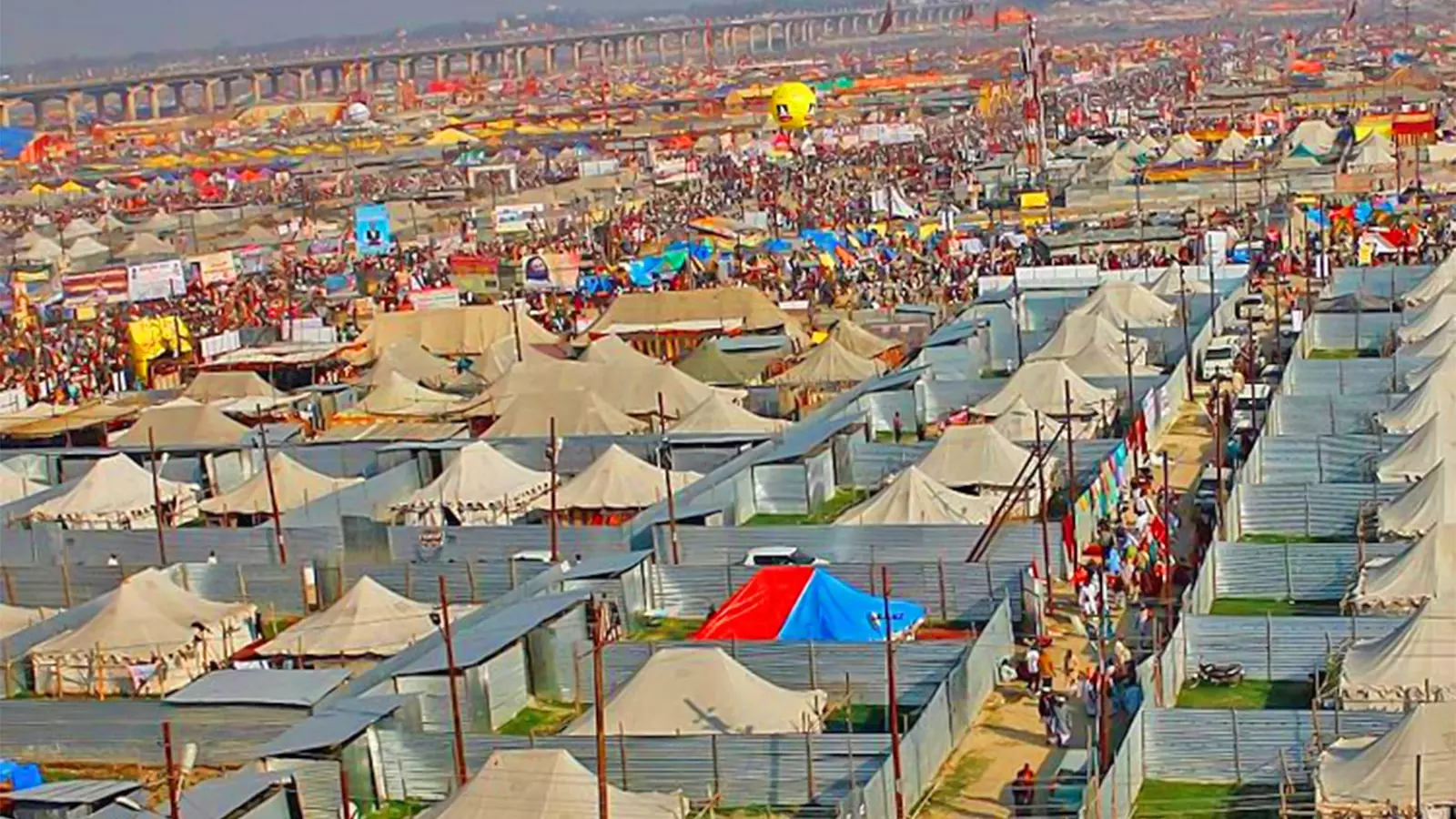
People flock to the city from across the country, some even on foot, to participate in one world’s largest pilgrimages - the Magh Mela.
Among all these melas, Prayagraj Magh Mela is a special one where people come and camp on the river banks for more than a month and a half, a period known as Kalpwas. During Kalpwas, they take holy dips on at least 6 days considered auspicious, starting with Makar Sankranti and spread over the full-moon and new-moon days of Paush Purnima, Mauni Amavasya, and Maghi Purnima, and the Spring Festival of Basant Panchami, and finally concluding on Maha Shivratri.
On these six days, around 50 to 60 million people would be taking a holy dip across the six bathing ghats of Vishnu Prayag, Dev Prayag, Rudra Prayag, Nand Prayag and Karna Prayag besides Sangam and each one of them has its own unique mythological heritage and spiritual significance.
Riverine civilisations have spawned their own cultures including religious cultures. As they sustain life of the peasantry, rivers are considered holy.
The holy dip
A dip in Ganga is considered holy by Hindu believers. Prayagraj being the spot of confluence of holy rivers Ganga and Yamuna and a mythical river Sarawati is unique and holy for Hindus. A dip in Ganga on some select auspicious days like Makara Sankranti is supposed to be the holiest.
A holy dip is meant not only to cleanse the body. Symbolically, it is an act washing away one’s sins, an act of spiritual cleansing. In some special cases, even a holy dip is even considered a ticket to heaven, that is, attaining moksha (salvation). Attaining moksha is supposed to lend deliverance from the cycle of birth-rebirth as per the religious belief of Hindus.
Certain ghats attract people from hundreds or even thousands of kilometres away. The travel for holy dip is also a spiritual act. It is a spiritual journey known as teerth yatras. The yatra is often padyatra, a journey on foot. But it is no ordinary journey. Imagine walking for 100–150 kms in biting cold. The physical exertion for the long march is sustained by the religious spirit. Powered solely by the strength of faith people take a dip in freezing cold waters of a river in the early hours amidst dense fog, not just once but on at least six occasions across several ghats.
Even though transport is available and affordable, many people choose to walk, even for five-six days, covering 100 kms or more believing the ‘sacrifice’ would bring them closer to God. Often, entire villages march in unison, singing hymns and chanting shlokas. People living along the way offer them food and refreshments and that is considered an act of punya (a noble deed). Religion has several dimensions—the doctrinal, the ritual, the experiential and the mass celebratory facets. Pilgrimage is a combo of ritual and experiential dimensions of religion.
Sociologically speaking, Magh Mela is a post-harvest peasant festival. After the hard toil for raising a crop, the peasants get some disposable income in their hands. It is time for merriment and relaxation and also for an exercise of devotion to thank the Gods for a plentiful harvest. Many set out on this experiential expedition. Coming together periodically in huge gatherings in multitudes is part of peasant culture. Such congregations are counterpoints of the day-to-day atomized isolated existence.
While ablutions are known in other religions, holy dip or snan appears to be exclusive to Hinduism. Not only men, even women undertake teerth yatras in large numbers. In Bihar, Chhat Puja is performed primarily by women standing waist-deep in Ganges after taking holy dips. Often, holy dips are associated with fasts and other religious ceremonies.
An inclusive mela
Magh Mela is a great leveller by virtue of being caste neutral. People of all castes go and take a holy dip in Ganges on the Magh Mela. Still, of late, casteism is at play in a subtle manner where the ghats for upper castes, intermediate peasant castes and labouring Dalits, and other lower castes are segregated with the latter located downstream after the upstream ghats reserved for upper castes.
“Different areas and times have been fixed for different Akhadas and the Naga sadhus to bathe. Shahi snan area is reserved only for the Shankaracharyas,” a senior government official in Lucknow told The Federal.
The event is symbolically secular. Prof Neelam Saran Gaur, a chronicler of Allahabad’s urban evolution who was recently given Sahitya Academy award and who is the author of two books Allahabad: Where the River Meet, and Requiem in Raga Janki told The Federal, “Muslim artisans used to bring their wares, brass statues of gods and goddesses, their dresses with intricate zari work, clay toys and statues, incense sticks etc. Buddhists used to participate in Kalpavas and have shaasrarth with Hindu seers. The mela was an inclusive affair. But in recorded history, only one Muslim man said he had a holy dip in the Ganges. Huen Tsang has written about a violent feud between Buddhists and Hindus in one of the Magh Melas.”
Yash Malaviya, a renowned cultural personality in Prayagraj, says, “Magh Mela or Khumbh melas represented sarv dharm sambhav (communal harmony). They were not associated with any particular religion. They were fairs meant for all. Prof Lal Bahadur Verma, a progressive intellectual, had initiated Srijan—a cultural event in which Sufi performances were held, there were dramas and discourses of a secular nature. But over the last three years, the district administration didn’t allot space to them. Exclusivism dominates now.”
Magh Mela used to symbolise the syncretic legacy of Ganga-Jamunee tehzib. Sadly, it has started fading now.
A carnivalesque mega fair
Magh Mela, unlike ordinary melas, is a unique event combining religious rituals with festivities. It is not just a routine festival, but acquires the dimension of a mega carnival. It is a sea of humanity that celebrates. In 2019, huge crowds were milling through all the roads in Allahabad and it took a couple of hours to cross even 1 km on foot in the main approach roads leading to Sangam.
In recent years, thanks to the dominance of money, Magh Mela too has turned into a commercial event instead of being a mere religious socio-cultural occasion. Religious tourism has become an industry and melas offer a brisk business opportunity. Imagine a gargantuan sized supermarket with 15,000–20,000 shops. The whole town comes to resemble that during the melas. The peak festival season sales do not end with Sankranti here but stretch till mid-March. Merchants earn more in two months than what they earn in the rest 10 months. Migrating businesses take back greater earnings while returning from the mela than what they would otherwise earn in the whole year in their native towns.
Yogi Adityanath swings into action
The Yogi-led administration is a bundle of contradictions. While it has not shown any appreciable results in industrial development and employment generation, it is exerting itself to the utmost in organising religious events. While the officialdom in UP is characterised by slothfulness and general incompetence, they work with a peculiar zeal when it comes to organising religious events to please the powers that be.
The Yogi government, in fact, earned wide appreciation for the efficient manner in which it organized Ardh Kumbh in 2019. Imagine a sea of humanity of 12 crore people thronging a small town of 25 lakh population. That would be a logistical nightmare for any administration. Yogi wisely requested the Army to take over the logistics management and crowd control and the Army jawans and officials did an admirable job in regulating the crowds and preventing stampedes.
All the main roads in Allahabad were newly laid. All public squares were spruced up. Public paces started looking spick and span. Building tourism infrastructure got a big boost with an outlay of more than Rs 5000 crore. Naturally, Yogi earned a lot of praise for that.
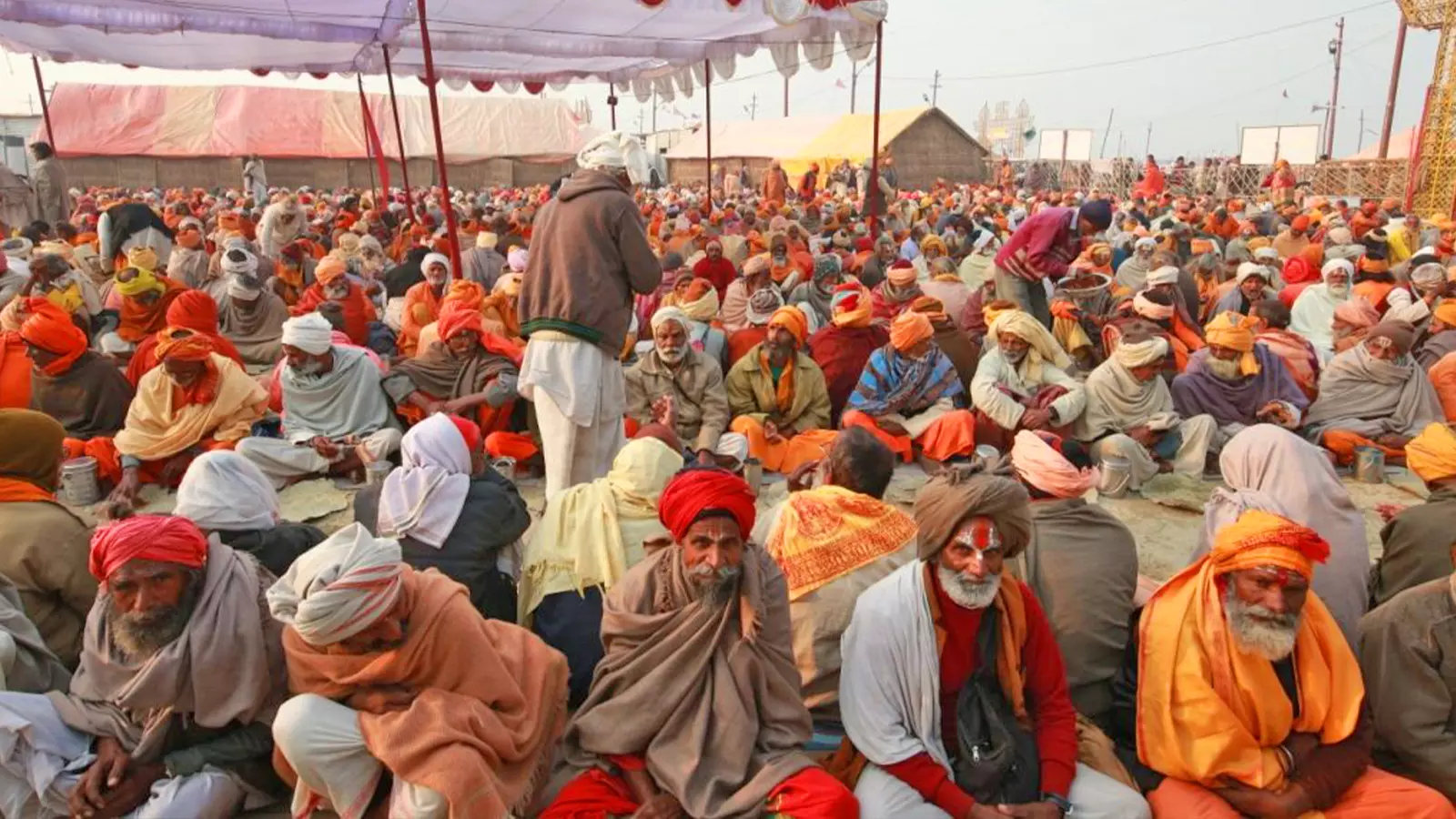
The Yogi government is trying to encash on the religious fervour of congregations.
Encouraged by that praise, Yogi swung into action in November 2023 and put the entire administrative machinery to work to conduct a splendid Magh Mela this year too which he hopes could be a precursor for even a grander Kumbh Mela in 2025.
He personally visited Prayagraj on 28 December to oversee the preparations and convened meetings of officials from different departments. The tourism infrastructure is being upgraded. In a town that lacks underground drainage and sewerage systems, long pipelines are being laid from the core mela area around Sangam to facilitate proper drainage.
In 2019, for the first time in history, the state set up makeshift camps numbering more than 10,000 in about a dozen areas to enable the Kalpwasis to stay for nearly two months. This year, the administration is planning to increase the camps to more than 15,000 and different villages can do advanced booking for these camps at moderate costs.
Anticipating possible rains, to enable easy transportation on the riverbed, roads with thick metal plates are being laid for 100 kms around the six mela venues. Over 200 km-long pipelines have been laid for water supply and sanitation in the camp areas. A 65-km drainage system has already been completed. Construction of 21,000 makeshift toilets has been planned. The whole city would be brightened up with 18,000 LED lamps. To prevent traffic jams in the main arterial roads leading to Sangam, six pontoon bridges are coming up across Ganges and Yamuna to improve the flow of traffic from outer areas.
Strangely, Magh Mela preparations have created some heartburn among a section of traders. Vaibhav Maini, a member of INTACH Allahabad Chapter, who is active in renovating heritage buildings of Allahabad says, “While some surveys have been done and ghats are being renovated, road-widening is being done on many roads resulting in demolition of hundreds of shops and houses.”
Political exploitation of melas for votes
Yogi is smart enough to understand the electoral value of organising impressive melas to tap the Hindu vote bank. For organising the 2019 mela in a comparatively far better manner compared to the past, he reaped a good harvest in 2022 UP Assembly polls, winning 8 out of 12 assembly seats from Prayagraj. In the May 2023 polls to the Prayagraj Municipal Corporation too, the BJP won 56 out of 100 wards. As Yogi has national political ambitions, and is being seen as the next Hindu Hriday Samrat after Modi, he wants to register a good performance in the 2024 Lok Sabha polls.
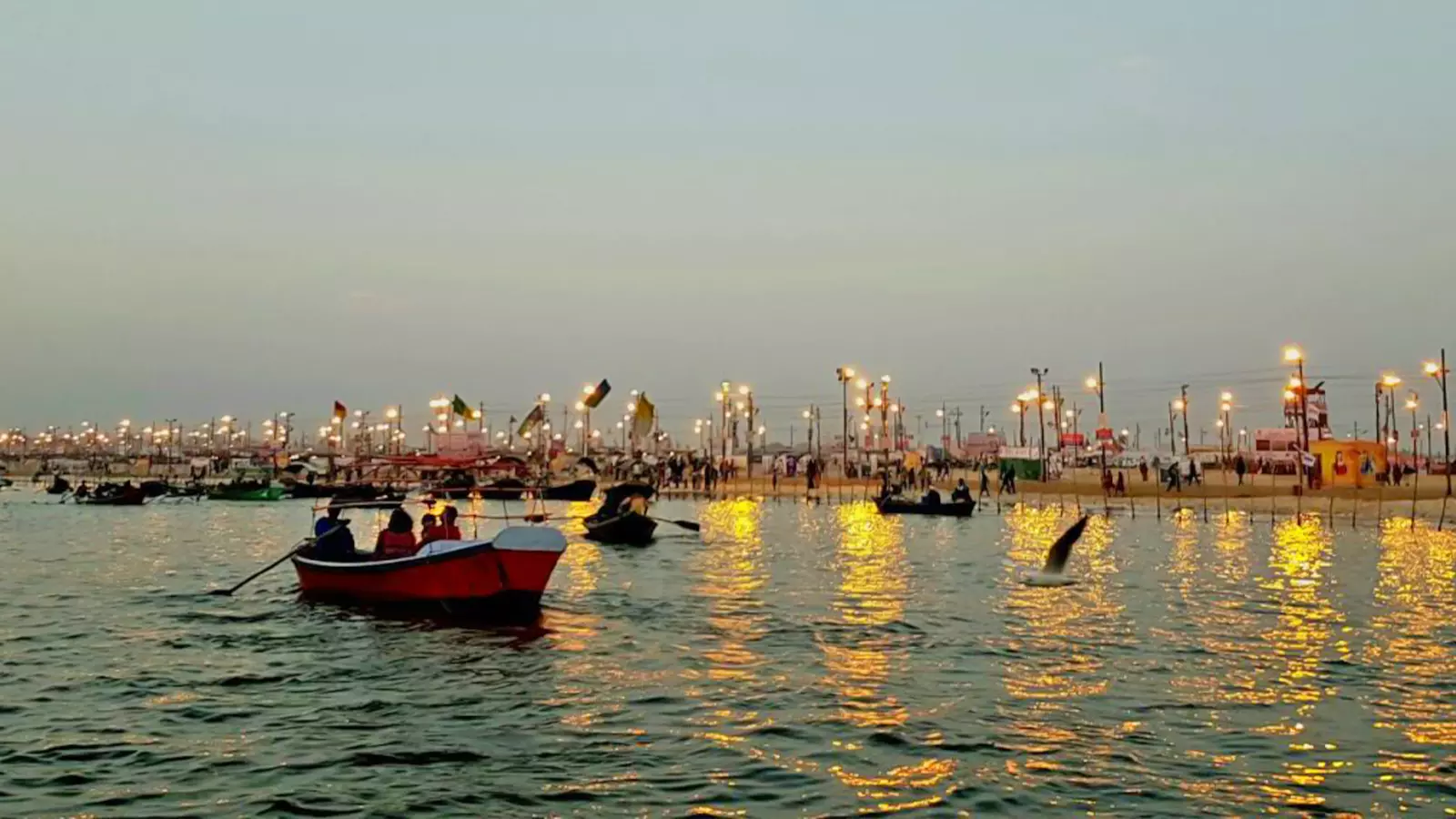
In social terms, Magh Mela is a joyous cultural carnival of millions marked by gala celebrations and joyful festivity — a mela in the true sense.
Since the BJP has apprehensions about the electoral arithmetic advantage of the opposition if Samajwadi Party and Congress come together and since there is also speculation that Mayawati might also consider joining the INDIA bloc, which eventuality would make the opposition quite formidable electorally, Yogi is leaving no stone unturned to ensure victory in politically prestigious Prayagraj Lok Sabha constituency and the two adjoining constituencies of Phulpur and Kausambhi where the opposition can give a tough fight. A magnificent Magh Mela is bound to reflect in BJP’s poll performance and improve Yogi’s political stock.
After all, contrary to the conventional notion of modernity that traditional cultural practices were waning with time, what we witness now is their recrudescence. This is not just because of people tracing their roots and retrieving the forgotten legacy. More so, it is because these melas turn into religio-commercial events instead of being purely religious-spiritual events where the emerging rural rich want to flaunt their status and newly acquired affluence. Yogi knows very well the political value of this social constituency.

